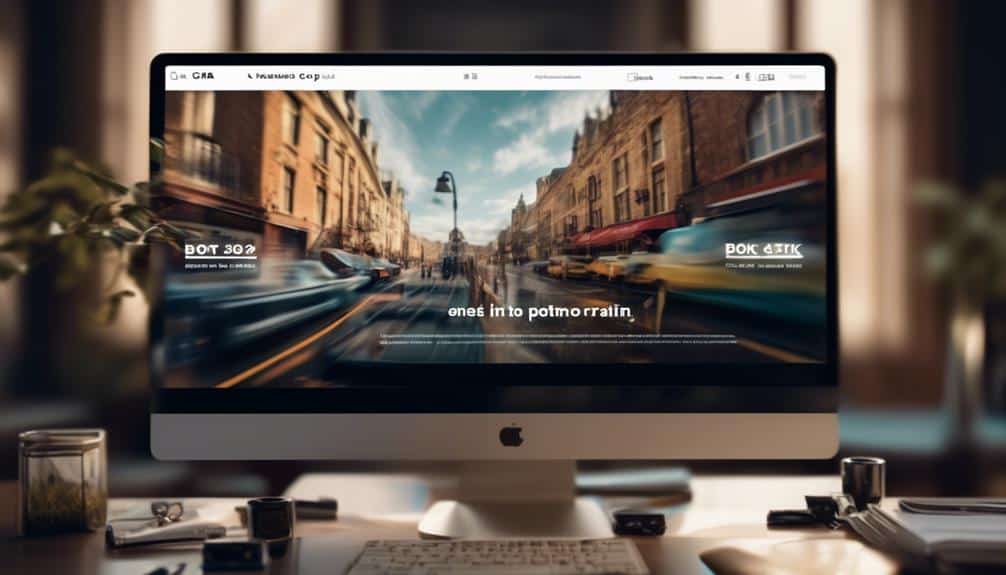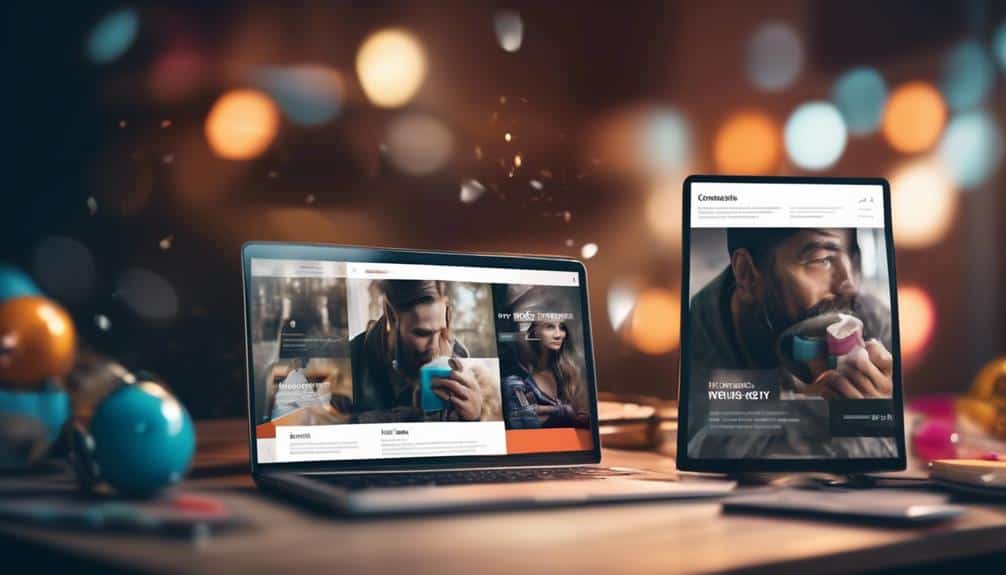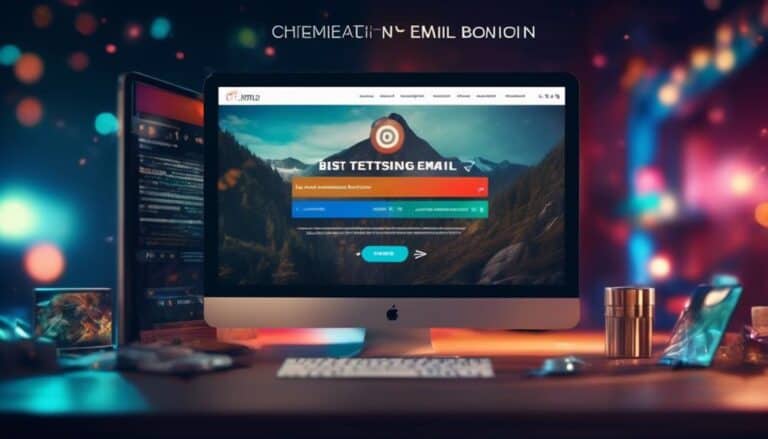Act Now: Essential Strategies for A/B Testing Email Content That Converts
Have you ever wondered why some email campaigns fail to generate the desired results while others consistently convert leads into customers? The answer lies in the art of A/B testing email content.
If you're looking to boost your email engagement and conversion rates, this discussion is for you. We will uncover essential strategies that can help you optimize your email content and drive more conversions.
So, buckle up and get ready to discover the secrets behind successful email campaigns.
Key Takeaways
- Segmenting and targeting email campaigns based on specific criteria can increase the relevance and effectiveness of the campaigns.
- Clearly defining objectives for A/B testing and prioritizing goals based on business importance can help optimize email open rates, click-through rates, and conversions.
- Isolating one element to test at a time and collecting precise data can help accurately measure the impact of variables on conversion rates.
- Optimizing subject lines and email copy/design by analyzing data, personalizing content, using storytelling techniques, and creating a sense of urgency can enhance email engagement and increase conversion rates.
Segment Your Email List

Segmenting your email list is a crucial step in optimizing your email content for maximum conversion. By dividing your subscriber base into distinct groups based on specific criteria, such as demographics, purchase history, or engagement levels, you can tailor your email campaigns to effectively target each segment. Email segmentation allows you to deliver personalized content that resonates with your audience, increasing their engagement and ultimately boosting your conversion rates.
To start segmenting your email list, begin by conducting an engagement analysis. This involves analyzing your subscribers' behavior, such as open rates, click-through rates, and purchase patterns. By understanding how different segments of your audience interact with your emails, you can identify opportunities for improvement and develop targeted strategies.
Once you have gathered the necessary data, use email segmentation to create distinct groups based on your analysis. For example, you can segment your list into active subscribers, lapsed customers, or high-value purchasers. By tailoring your content and offers to each segment's specific needs and preferences, you can significantly increase the relevance and effectiveness of your email campaigns.
Incorporating email segmentation into your conversion rate optimization efforts can yield significant results. By delivering targeted, personalized content to your subscribers, you can enhance their experience, foster stronger relationships, and ultimately drive more conversions.
Determine Your Testing Goals
To effectively optimize your email content for maximum conversion, it's essential to establish clear and measurable goals for your A/B testing. Testing objectives and test duration estimation play a crucial role in determining the success of your email campaigns.
Here are three sub-lists to help you understand the importance of setting testing goals:
- Identify your goals:
- Clearly define what you want to achieve through A/B testing.
- Are you looking to increase open rates, click-through rates, or conversions?
- By setting specific objectives, you can focus your efforts and measure the impact accurately.
- Prioritize your goals:
- Determine which goals are most important to your business and prioritize them accordingly.
- This will help you allocate resources effectively and ensure that you're testing the elements that have the most significant impact on your conversions.
- Estimate test duration:
- Consider the size of your email list and the expected response rate to estimate how long your A/B tests should run.
- A longer test duration allows for more accurate results, while a shorter duration can provide quick insights for time-sensitive campaigns.
Test One Variable at a Time

When conducting A/B testing for email content that converts, it's crucial to test one variable at a time. By isolating one element, such as button color or subject line length, you can accurately measure its impact on conversion rates.
Testing multiple variables simultaneously can lead to inconclusive results and make it difficult to determine which element is truly driving the desired outcome.
Stay focused, collect precise data, and optimize your email content for maximum conversion.
Button Color Impact
Testing button color impact is a crucial step in optimizing email content for conversion. The color of your call-to-action button can greatly influence the user's decision to click or not. Here are three key factors to consider when testing button color impact:
- Contrast: Experiment with different colors to find the one that stands out the most against your email background. A high contrast between the button color and the rest of the email content can grab the reader's attention and encourage action.
- Psychological associations: Different colors can evoke different emotions and associations. Test various button colors to see which ones resonate best with your audience and align with the desired action you want them to take.
- Brand consistency: While it's important to test different button colors, it's equally important to maintain brand consistency. Ensure that the chosen color aligns with your brand identity and doesn't create confusion.
Subject Line Length
To continue optimizing your email content for conversion, it's important to now focus on the subtopic of subject line length, testing one variable at a time.
Subject line effectiveness plays a crucial role in determining the open rate of your emails. By analyzing open rate data, you can gain valuable insights into the impact of subject line length on your audience's engagement.
A/B testing different subject line lengths allows you to gather concrete data and make informed decisions about your email content. Start by creating two versions of your email with different subject line lengths and track the open rates for each.
This data-driven approach will enable you to identify the optimal subject line length that resonates with your audience and drives conversions. Remember, testing one variable at a time ensures accurate results and empowers you to serve your audience effectively.
Create Compelling Subject Lines
Craft subject lines that captivate and drive open rates through the roof. To create compelling subject lines, follow these strategies:
- Creating emotional connection:
- Personalize subject lines by using the recipient's name or location.
- Incorporate relevant and timely information to show that you understand their needs and interests.
- Use storytelling techniques to evoke emotions and make the subject line more relatable.
- Using persuasive language:
- Highlight the benefits or value the reader will gain by opening the email.
- Create a sense of urgency by using words like 'limited time offer' or 'exclusive deal.'
- Spark curiosity by posing a compelling question or teasing intriguing content inside.
Crafting subject lines that captivate requires a data-driven approach. Analyze past email campaigns to identify subject line patterns that resonated well with your audience. Experiment with different techniques and track the open rates to determine what works best.
Remember to keep the subject line concise and clear, avoiding any unnecessary words that might dilute the message.
Optimize Email Copy and Design

To optimize your email copy and design, you need to employ effective copywriting techniques and follow design best practices.
Crafting compelling and persuasive email copy helps capture your audience's attention and encourage them to take action.
Simultaneously, implementing design elements that are visually appealing and easy to navigate enhances the overall user experience and increases the chances of conversion.
Copywriting Techniques for Emails
Using proven copywriting techniques in your email content can significantly increase conversions. To optimize your email copy and improve email engagement, consider the following tips:
- Personalization: Tailor your content to the individual recipient by using their name and addressing their specific pain points or needs.
- Clear and concise messaging: Keep your email content focused and to the point. Use short paragraphs, bullet points, and subheadings to make it easy to scan and digest.
- Compelling subject lines: Grab your reader's attention with a subject line that's both intriguing and relevant to the content of the email.
Design Best Practices for Emails
When optimizing your email copy and design, implementing design best practices is crucial for enhancing engagement and driving conversions. To create visually appealing and effective emails, you need to focus on responsive email templates and email layout optimization.
Here are three design best practices to consider:
| Best Practices | Description |
|---|---|
| Use Responsive Email Templates | Ensure your emails are mobile-friendly and adapt to different screen sizes. This improves user experience and increases the chances of recipients engaging with your content. |
| Optimize Email Layout | Keep your email layout clean and organized. Use white space strategically, making it easier for readers to scan and understand your message. Place important information and call-to-action buttons prominently. |
| Use Eye-Catching Visuals | Include relevant and high-quality visuals that grab attention and support your message. Use images sparingly to avoid overwhelming the email and slowing down load times. |
Test Different Call-To-Action Buttons
Test different call-to-action buttons to optimize email conversion rates. The placement and style of your buttons can significantly impact the success of your email campaigns. Here are three key considerations to keep in mind:
- Button placement: Experiment with different positions for your call-to-action buttons to determine the optimal placement. Try placing the button above the fold, where it's immediately visible to your readers. Alternatively, test placing it at the end of the email, after a compelling message, to capture readers' attention when they're most engaged.
- Button style: The style of your call-to-action buttons can influence click-through rates. Test different button colors, sizes, and shapes to see which ones resonate best with your audience. Consider using contrasting colors to make the button stand out, and make sure the text on the button is clear and action-oriented.
- Button copy: The text on your call-to-action buttons should be concise, compelling, and persuasive. Experiment with different copy variations to see which ones drive the highest conversions. Use action verbs and create a sense of urgency to encourage readers to take immediate action.
Experiment With Personalization Techniques

To further optimize your email conversion rates, now let's explore the effectiveness of personalization techniques in capturing your readers' attention and driving engagement.
Personalization techniques, such as customization and individualization, can significantly impact the success of your email campaigns. By tailoring your content to meet the unique needs and preferences of your audience, you can create a more personalized and relevant experience for them.
Experimentation with personalization allows you to implement various customization strategies and deliver personalized content that resonates with your subscribers. By using their names in the subject line or body of the email, you can grab their attention and make them feel valued. Additionally, segmenting your audience based on their interests or past behaviors enables you to send targeted emails that address their specific needs.
Research has shown that personalized emails result in higher open rates, click-through rates, and conversion rates. According to a study conducted by Experian, personalized emails deliver six times higher transaction rates compared to non-personalized ones. By leveraging personalization techniques, you can increase engagement and ultimately drive more conversions.
Analyze and Interpret Test Results
By analyzing and interpreting your test results, you can gain valuable insights and make data-driven decisions to optimize your email content for maximum conversion.
Here are three essential steps to help you analyze data and interpret findings effectively:
- Identify key metrics: Look at metrics such as open rates, click-through rates, conversion rates, and revenue generated. These metrics will provide you with an understanding of how your email content is performing and which variations are driving better results.
- Compare results: Compare the performance of different email variations side by side. Identify any significant differences in metrics and determine which elements of your email content contributed to those variances. This will help you understand what changes to make to improve your conversion rates.
- Dig deeper with segmentation: Segment your audience based on factors such as demographics, preferences, or purchase history. Analyzing test results within these segments can uncover valuable insights about which variations resonate best with specific groups of subscribers. This will enable you to tailor your email content and increase engagement and conversion rates for each segment.
Implement and Iterate for Continuous Improvement

Now that you have analyzed and interpreted your test results, it's time to implement and iterate for continuous improvement in your email content conversion. To optimize your conversion rates, you need to develop effective strategies that focus on continuous improvement. By constantly refining and enhancing your email content, you can ensure that it resonates with your audience and drives better results.
To help you in this process, here are three continuous improvement strategies that you can implement:
| Strategy | Description | Benefits |
|---|---|---|
| Personalization | Tailor your email content based on customer preferences and behavior to create a more personalized experience. | Increased engagement, higher conversion rates, and improved customer satisfaction. |
| A/B Testing | Continuously experiment with different variations of your email content to identify what resonates best. | Data-driven insights, improved understanding of customer preferences, and higher conversion rates. |
| Customer Feedback | Actively seek feedback from your customers to understand their needs and preferences. | Better understanding of customer expectations, opportunities for improvement, and increased customer loyalty. |
Frequently Asked Questions
How Do I Segment My Email List Effectively to Maximize Conversions?
To segment your email list effectively for maximum conversions, use smart segmentation strategies. Analyze subscriber data, behavior, and preferences. Tailor your email content to each segment's needs and interests. Watch your email conversion rates soar!
What Are Some Common Testing Goals That Businesses Typically Have for Their Email Content?
When testing email content, businesses commonly aim to improve open rates and increase click-through rates. By utilizing A/B testing strategies, you can determine what resonates with your audience and optimize your email content for better conversion.
Why Is It Important to Test One Variable at a Time in A/B Testing?
When conducting A/B testing, it's crucial to test one variable at a time. This allows you to accurately measure the impact of each variable and understand how it affects your results. Testing multiple variables at once can lead to unclear and unreliable data, making it harder to optimize your email content. Additionally, the sample size plays a significant role in A/B testing results. With a larger sample size, you can have more confidence in your findings and make data-driven decisions to improve your email conversion rates.
How Can I Create Compelling Subject Lines That Grab the Reader's Attention?
To create engaging subject lines that grab the reader's attention, try these tips: keep it concise, use action words, personalize when possible, and create a sense of urgency. Your emails will stand out and drive conversions.
What Are Some Effective Personalization Techniques That I Can Experiment With in My Email Content?
To improve your email content, try personalization techniques like using the recipient's name, segmenting your audience, and tailoring the message based on their preferences. Experimenting with these email personalization strategies can increase engagement and conversion rates.
Conclusion
In conclusion, by implementing these essential strategies for A/B testing email content, you can optimize your campaigns for higher conversion rates.
Segmenting your email list, setting clear testing goals, and focusing on one variable at a time will help you gather valuable data.
Crafting compelling subject lines, optimizing copy and design, and experimenting with call-to-action buttons and personalization techniques will further enhance engagement.
Finally, analyzing test results and implementing continuous improvements will ensure long-term success in your email marketing efforts.
Act now and start converting more with your email content.








